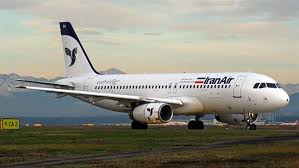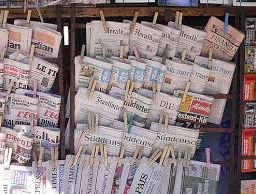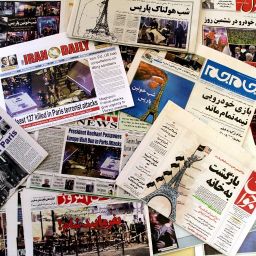Third plane bought under sanctions deal arrives in Iran (Reuters, 25 March 2017)
On 25 March 2017, the third Airbus pl ane of the 100 aircraft-deal sealed by Iran last year arriced in Tehran. The long-haul A330-200 landed at Tehran’s Mehrabad airport, joining another A330 and a smaller A321 delivered to Iran earlier this year by Airbus. Iran’s pragmatist president Hassan Rouhani’s success in ending international sanctions by reaching a deal with world powers has also intensified tensions ahead of May presidential elections with hardliners, who have criticized the deal for a lack of tangible economic benefits since sanctions were lifted. Iran has ordered 100 airliners from European planemaker Airbus and 80 from Boeing and is in talks to finalize a deal to buy 20 turboprop aircraft from ATR, jointly owned by Airbus and Italy’s Leonardo Finmeccanica.
ane of the 100 aircraft-deal sealed by Iran last year arriced in Tehran. The long-haul A330-200 landed at Tehran’s Mehrabad airport, joining another A330 and a smaller A321 delivered to Iran earlier this year by Airbus. Iran’s pragmatist president Hassan Rouhani’s success in ending international sanctions by reaching a deal with world powers has also intensified tensions ahead of May presidential elections with hardliners, who have criticized the deal for a lack of tangible economic benefits since sanctions were lifted. Iran has ordered 100 airliners from European planemaker Airbus and 80 from Boeing and is in talks to finalize a deal to buy 20 turboprop aircraft from ATR, jointly owned by Airbus and Italy’s Leonardo Finmeccanica.
Megaplast ready to start in Iran (Polimerica.it, 21 March 2017)
The manufacturer Megaplast has signed a letter of intent to establish a joint-venture with the Iranian Riseco. The new company will manufacture and sale of car components for the vehicle Iranian manufacturers. With the reopening of the Iranian market, after years of economic embargo, domestic production of cars, mostly cars, amounted to 1.3 million vehicles a year. Based in Tehran, the new joint venture will be controlled in equal parts by Mecaplast-Key Plastics and Riseco, both auto parts suppliers.
Iran struggles to coax Bank of England to open clearing accounts (Reuters, 20 March 2017)
Iran has asked the Bank of England to set up special clearing accounts for its banks, but has so far been rebuffed in its effort to resolve an impasse that has left it excluded from banking in London more than a year after sanctions were lifted. Banking sources from both Iran and the West, and Iranian political sources close to the talks, said Tehran has approached the Bank of England to seek clearing accounts directly with the UK central bank. Such accounts, for Iran’s own Central Bank or for the British subsidiaries of Iranian banks, would allow them to make and receive payments in sterling, business so far rejected by commercial banks. That would send a huge message to the market. Three Iranian banks have subsidiaries with licenses to operate in Britain: Melli Bank Plc, Bank Sepah International Plc and Persia International Bank Plc. But none has been able to persuade a commercial bank to clear its payments in sterling. Iran considers the failure of Western countries to allow it back into the international financial system to violate the spirit of the 2015 nuclear deal. The issue is particularly sensitive within Iran for the future of the nuclear deal’s architect, President Hasan Rouhani, a pragmatist elected in a landslide in 2013 on a promise to reduce Iran’s economic isolation. He faces re-election in May against hardliners who say his deal has never yielded the promised economic benefits. The UK government, eager to boost trade with new markets like Iran after last year’s vote to leave the European Union, has struggled to convince British banks to boost trade with Iran.
219 foreign delegations negotiate insurance co-op with post-sanction Iran (Tehran Times, 25 March 2017)
According to the Iranian news agency ISNA, since January 2016 and implementation of the JCPOA, some 219 foreign delegations have visited the country to negotiate cooperation in different areas including insurance. Tokyo Marine, the largest property/casualty insurance group in Japan, Sompo Holdings Inc., and Mitsui Sumitomo Insurance Group, which hold 90 percent of Japanese insurance market, have announced their readiness to offer up to $200 million insurance coverage in Iran and also set up joint insurance company in the Islamic Republic. Munich Re Group, a reinsurance company based in Munich, Germany, which is one of the world’s leading reinsurers, and SCOR, the French reinsurance company providing Property and Casualty (P&C) and Life reinsurance solutions, are among the world’s top insurers that have voiced their preparedness for investment making and technology transfer to the Iranian insurance sector in post-sanction time.
Iran to more than double renewable capacity in one year (Power Engineering International, 24 March 2017)
 Iran’s installed renewable power capacity is set to reach 700-850 MW within the country’s calendar year (21 March 2017-20 March 2018), the Energy Ministry has announced. The increase would more than double Iran’s current installed renewable capacity, which Deputy Energy Minister Mr. Mohammad Sadeqzadeh put last month at around 340 MW. the bulk of the expected capacity would come from wind and solar photovoltaic (PV) farms, which are set to provide 90 per cent of the total amount to be installed. The new plants will be between 10 MW and 30 MW and will be built across the country, Sadeqzadeh said. Five waste-to-power plants are also under construction, for a total capacity of 9 MW. Iran aims to grow its renewable capacity to 7.5 GW by 2030, with 5 GW targeted under its sixth five-year development plan (2016-2021).
Iran’s installed renewable power capacity is set to reach 700-850 MW within the country’s calendar year (21 March 2017-20 March 2018), the Energy Ministry has announced. The increase would more than double Iran’s current installed renewable capacity, which Deputy Energy Minister Mr. Mohammad Sadeqzadeh put last month at around 340 MW. the bulk of the expected capacity would come from wind and solar photovoltaic (PV) farms, which are set to provide 90 per cent of the total amount to be installed. The new plants will be between 10 MW and 30 MW and will be built across the country, Sadeqzadeh said. Five waste-to-power plants are also under construction, for a total capacity of 9 MW. Iran aims to grow its renewable capacity to 7.5 GW by 2030, with 5 GW targeted under its sixth five-year development plan (2016-2021).
Iran plans to divert Gulf waters to southern regions affected by drought (Agenzia Nova, 24 March 2017)
Iran is considering an ambitious project to divert water from the Gulf of Oman to the location of its central plateau with the aim to end the water crisis in the country and develop the economy of depressed regions due to the frequent droughts has announced governor of the southern province of Kerman, Mr. Alireza Hosseini. Work to dig the tunnel to carry water from the Gulf of Oman to the central plateau started already in December 2015, but the situation of severe drought is hitting the country has prompted the authorities to speed up the conclusion of the project. The tunnel project is led by the Iranian company Kach. Mr. Hosseini said that President Hassan Rohani has already allocated the necessary funds for infrastructure, which when completed will represent the most important project for the entire Middle East water transfer. The governor said that water will be desalinated with a number of plants situated on the coast before being moved inland through a series of pipes and tunnels to cross the mountain ranges. He added that the government has prepared a number of plans to prevent further depletion of groundwater resources by encouraging the cultivation which use less water, such as saffron and barberry. Mr. Hosseini also pointed out that farms have renewed the methods of wheat and corn irrigation to minimise wastage.
Large petrochemical complex costing €257m inaugurated in western Iran (Tehran Times, 25 March 2017)
A large petrochemical complex came on stream on 25 March 2017 in the western province of Kordestan. Some €257 million has been invested in the project, which started in 2005. The Kordestan Petrochemical Complex is projected to produce 310,000 tons of light polyethylene per year, which are mainly used in downstream industries for manufacturing plastic parts and wire sleeves. Iran’s petrochemical production, which stood at 46.4 million tons in the Iranian calendar year 1394 (March 2015-March 2016), is planned to soar to 180 million tons over the next ten years, according to the National Petrochemical Company. The NPC Managing Director Mrs. Marzieh Shahdaie said in August 2016 that Iran needs $20 billion of investment to complete unfinished petrochemical projects across the country in 5 years.


